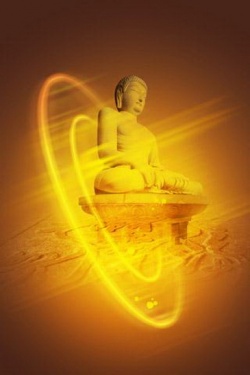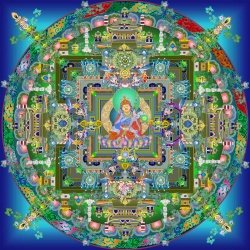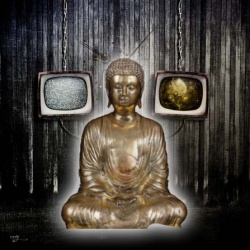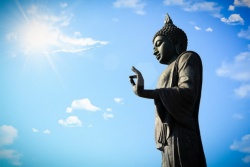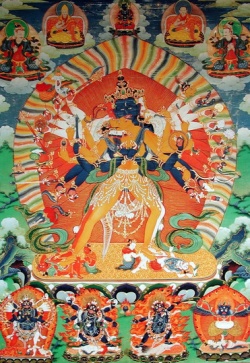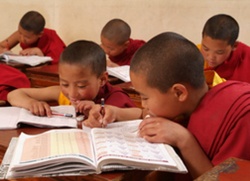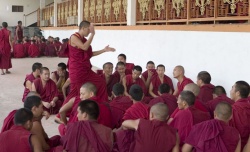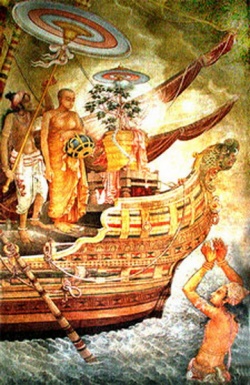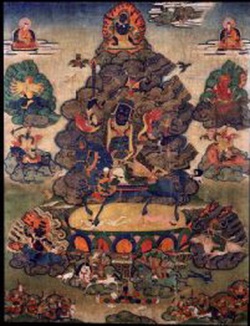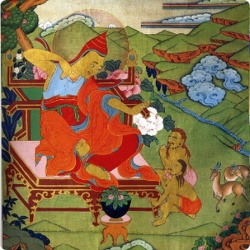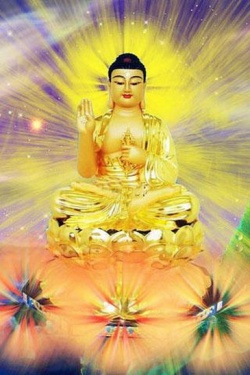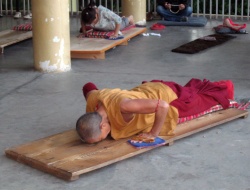Tantric Ordination: The Ngak’phang Tradition by Ngak’chang Rinpoche
The ngakphang tradition is colorful, individualistic, and highly heterodox.
The ngakpas and ngakmas, are the ordained, robe-wearing members of this tradition.
They are neither ‘lay’. nor ‘monastic’. nor ‘in between’; and defy all attempts to pigeon-hole them into the neat and tidy categories of authoritarian institutions.
They are a parallel stream of practice to that of the better known monastic sangha, and represent an opportunity for western people to establish the highest possible commitment to the Buddhist path without having to become celibate."
Those who have been regular readers of Sang-ngak-chö-dzong publications over the last ten years will have become familiar with the words ‘ngakphang’. and the term ‘ngakphang sangha’.
But for those who are new to Vision, we would like to give some information in non-scholastic language.
Most people who have some familiarity with Buddhism, and who have some basic reading behind them, will know that the dominant picture of Buddhist practice is monastic.
They will know that this is especially true of the East, and that it is also partially true of the West – especially in terms of the more established centers.
Many people who have attended Buddhist teachings in the West, will have received them from monks or nuns; or, failing that, may have listened to talks by lay students of monastic teachers.
Some of these lay people may have been ex-monks or nuns, and some will have been the scholastically inclined students of celibate teachers
The editorial committee, and subscribing writers, for Vision magazine accept this picture as being ‘the dominant image of Buddhist practice’. but seek to provide glimpses of other images – not only from Tibet, but where-ever alternatives to monasticism exist.
We seek to inform Western people of traditions that are not as well known as the monastic traditions.
We are setting out in a bold, determined, and very deliberate endeavor to provide access to something that is somewhat hidden … but which has existed since the dawn of Buddhist Tantra in India – the ngakphang tradition.
We will begin by exploring some of the words you will have read in previous issues of this magazine.
Let us begin by looking at the term ngakphang sangha. So – ngakphang; what does it mean?
Ngak is the Tibetan equivalent of the Sanskrit word mantra.
Mantra is a word that is understood in many ways according to tradition – even according to ‘new age’ concepts.
This is maybe not the occasion to define mantra too closely or broadly.
Mantra means ‘that which protects the Mind’. but ngak is not an exact translation of that.
Ngak means ‘spell’. ‘word’. or ‘word of power’ according to context.
Sang-ngak-chö-dzong publications usually translate ngak as ‘awareness-spell’ in order to convey something of the flavor of how this term is understood.
It is a ‘spell’ in the sense that it achieves something unusual or extraordinary;
but it is linked with awareness.
Awareness in this context means rigpa – the non-dual state of instant-presence.
In this sense ‘awareness-spell’ comes close to the meaning of mantra – that which protects the Mind.
Phang means ‘having the power and authority to use something’.
It means having the skill and experience to accomplish something – and here, the tool or method of accomplishment is ngak.
Connected with the word ngakphang are the words ngakpa and ngakma.
Pa and ma mean almost what their sound in English might indicate – male and female.
A ngakpa is a male ngakphang practitioner and a ngakma is a female ngakphang practitioner.
The word ngakphang sangha refers to the ordained community of ngakphang practitioners.
We use the word sangha rather than its Tibetan equivalent ‘gendün’ simply because the word sangha is too well known amongst the Buddhist community in the West for us to use the Tibetan word.
Our primary aim is to communicate!
Sangha is understood in different ways according to tradition.
Some traditions – particularly the Theravadin tradition, and the Tibetan Gélug school, understand sangha to mean the community of monks and nuns.
Other traditions include all active practitioners as sangha.
If we had to choose between the two definitions, we would choose the more inclusive definition – but fortunately there are other definitions.
It is common within the Nyingma tradition to describe the disciples of a Lama as his or her sangha, and this definition is also in vogue amongst Ka-gyüd and Sakya Lamas.
This is obviously a useful way to use the word, and accords with the sense of spiritual community that is vital if Buddhism is to be of use to people in the West.
There is however another use of the word sangha, in which we speak of [[ordained] sangha]], or sanghas – there are two.
These ordained communities are the red sangha of monks and nuns, and the white sangha of ngakpas and ngakmas.
This is something that only exists in the Nyingma tradition.
There are ngakpas and ngakmas in the Sakya and Ka-gyüd schools, but they are not defined as sanghas.
The special characteristic of the Nyingma school is that it recognizes the validity of the ngakphang ordination as being equal with the monastic ordination, and as being one of the two recognizable wings of the Nyingma tradition.
Padmasambhava singed Tri-song Détsen’s beard with a glance
Since the time of King Tri-song Détsen (c. 740-798) the red and white sanghas of the Nyingma tradition have sat on the right and left sides of the assembly of practitioners.
In the time of King Ralpachen (reigned 815-836, assassinated c. 836) there was a famous occasion on which King Ralpachen unbraided his long tresses of hair; laying them out so that both sanghas sat on his hair.
The red sangha sat on his right hand side, and white sangha sat on his left.
By this means, he displayed that he considered the ordained sanghas to be of greater worth than he himself as the King.
This was one of the high points in the history of the white sangha; but ironically the point at which Ralpachen’s brother became so incensed that he decided he had to assassinate him.
This violently intentioned brother of Ralpachen was none other than the notorious Langdarma.
He is often portrayed as a proponent of Bön, but that is not accurate – he was actually simply a proponent of the monarchy; and of himself.
Under the Bön system the King had the most elevated position in the land; but with Buddhism, especially Vajrayana Buddhism, this position was radically altered.
When Padmasambhava came to Tibet, King Tri-song Détsen expected to meet him as an equal, but came face to face with his own inadequacy immediately.
Padmasambhava singed Tri-song Détsen’s beard with a glance; and the king, knowing where he stood in relation to Padmasambhava, immediately offered prostrations. That point marked the end of secular monarchy in Tibet, and up to recent times Tibet was a theocracy.
Langdarma’s main thrust of attack, after the assassination of his brother and his claiming sovereignty, was the monasticinstitutions.
He destroyed monasteries and forced monks to marry, and embrace the Bön religion.
His intention was also to destroy the ngakphang sangha, but decided to leave well alone.
He had attempted to hunt down the main ngakphang practitioners, but when he confronted Vairochana he changed his mind.
Vairochana manifested a scorpion the size of a yak over Langdarma’s head, and the terrified King decided that he would be content with subjugating the monasteries.
After the assignation of Chö-gyal Ralpachen, a bleak period followed in which Buddhism went underground.
During this period it was the ngakphang Lamas who kept the Nyingma lineages alive – they are therefore held in high regard in the Nyingma school.
Had it not been for the ngakphang sangha, the Nyingma lineages would have died out.
The history of this period is obviously much more complex and detailed than we have described here; but we hope that this will suffice as an introduction to our tradition.
The ngakphang tradition is colorful, individualistic, and highly heterodox.
The ngakpas and ngakmas, are the ordained, robe wearing members of this tradition.
They are neither ‘lay’, nor ‘monastic’, nor ‘in between’ and defy all attempts to pigeon-hole them into the neat and tidy categories of authoritarian institutions.
They are a parallel stream of practice to that of the better known monastic sangha, and represent an opportunity for western people to establish the highest possible commitment to the Buddhist path without having to become celibate.
This is obviously a wonderful opportunity for those who are inspired by Buddhism, but whose personalities are not in tune with celibacy.
But this also poses something of a threat to those who see Buddhism as primarily monastic, and who see it as their duty to preserve the primacy of monasticism in the establishment of Buddhism in the West.
Many people consider that there are only two possibilities within Buddhism; ‘monastic’ or ‘lay’. and mainly the ‘lay’ option is seen as being inferior,
unless one happens to be a Tibetan tulku (who has either given up monastic vows, or who never received them).
But ‘lay’ is a word that has been appropriated, by many Buddhists who use the English language, to mean ‘non-celibate’.
This is unfortunate, because the actual dictionary definition of the word lay is as follows:
"‘lay’ adj. 1. of, involving, or belonging to people who are not clergymen.
2. non-professional or non-specialist; amateur."
There are both celibate and non-celibate tulkus – but there are no ‘lay tulkus’. or ‘lay Lamas’.
No Lama can be described as non-professional or non-specialist. There are Lamas who hold neither monastic ordination nor ngakphang ordination, especially in the Dzogchen tradition, but there are no lay Lamas.
To use ‘lay’ to mean ‘non-celibate’ also leads to confusion when speaking of non-celibate religious orders that are not Buddhist.
At a time in which political sensitivity advises care with language, we should pay attention to the inadvertent prejudice inherent in classifying non-celibate practitioners as ‘lay’.
Judaism, Christianity, and Islam all have non-celibate clergy, and it would be highly disrespectful to classify them as non-professional, non-specialist, or amateur – let alone not of the clergy.
The ngakphang ordination is based on Tantric vows, and is therefore different in its character to the ordination taken by monks and nuns.
In our next issue of Vision we will look more closely at the ngakphang ordination, and explain the meaning of its vows and its costume.
This is our first essay on the ngakphang sangha, and we hope to provide a continuing series of articles on the subject.
These articles will range from simple presentations to material that has been researched at the most academically pains-taking level – and we hope to keep a good balance between the material.
1. Pronunciation. No western language seems to have ‘ng’ as a sound with which words begin.
This makes ngak a difficult word to enunciate for most people.
We do however have this sound in the middle of words – such as: Hanger, hanging, singer, and singing We also have it at the end of words – such as hung, hang, sing, and sung. We can obviously pronounce it quite well!
All we need to do is make the sound at the start of a word rather than the middle or the end.
One could practice any word with the ‘ng’ in middle, and gradually drop the sound that precedes it.
Then we come to the vowel.
The are no hard vowels in Tibetan, so ‘rat’ would sound like ‘rut’ – and ‘ngak’ like ‘nguk’.
The vowels, in general, sound as follows: a = uh (or ah at the end of a word); e = ay; i = ee; o = oh; u = oo (as in ‘look’ rather than in spook.)
There are other vowels for which we use German and French accents, but we will explore those when we look at the words to which they apply. Then we have ‘phang’. which is not pronounced either ‘fang’ or ‘fung’ – but pung.
In Tibetan the ‘ph’ is an aspirated ‘p’.
There is no need to attempt perfect diction with these words.
A reasonable attempt at accurate pronunciation is all that is required in order to be understood – whilst n-gak fang may well be met with a stifled giggle … Read on if you dare.
2. ‘Mantra – Sacred Words of Power’ by John Blofeld is a readable book on the subject, and given its shortcomings, is very informative.
3. This is why our journal is called ‘Hidden Word’ – hidden-word is one possible translation of ‘sang-ngak’ as in sang-ngak chö;
which is another name for Tantra, Vajrayana, or secret-mantra-yana.
Sang-ngak-chö-dzong means therefore: Fortress of Tantra.
4. Nyingma means ancient, and is the name for the oldest tradition of Tantric Buddhism in Tibet.
The Nyingma is called a tradition rather than a school, because it was not developed as a school in the way the other schools evolved.
Nyingma was simply the Buddhism that was taught in Tibet by Padmasambhava the second Buddha. Today it is comprised of a collection of heterodox lineages.
5. Gen-mar and gen-kar (gendün marpo – red community, and gendün karpo – white community.
6. There are many ngakphang practitioners especially within the Drükpa Ka-gyüd and Dri-gung Ka-gyüd schools.
8. This has had its own particular problems – but these cannot be discussed within the context of this formative essay
.

